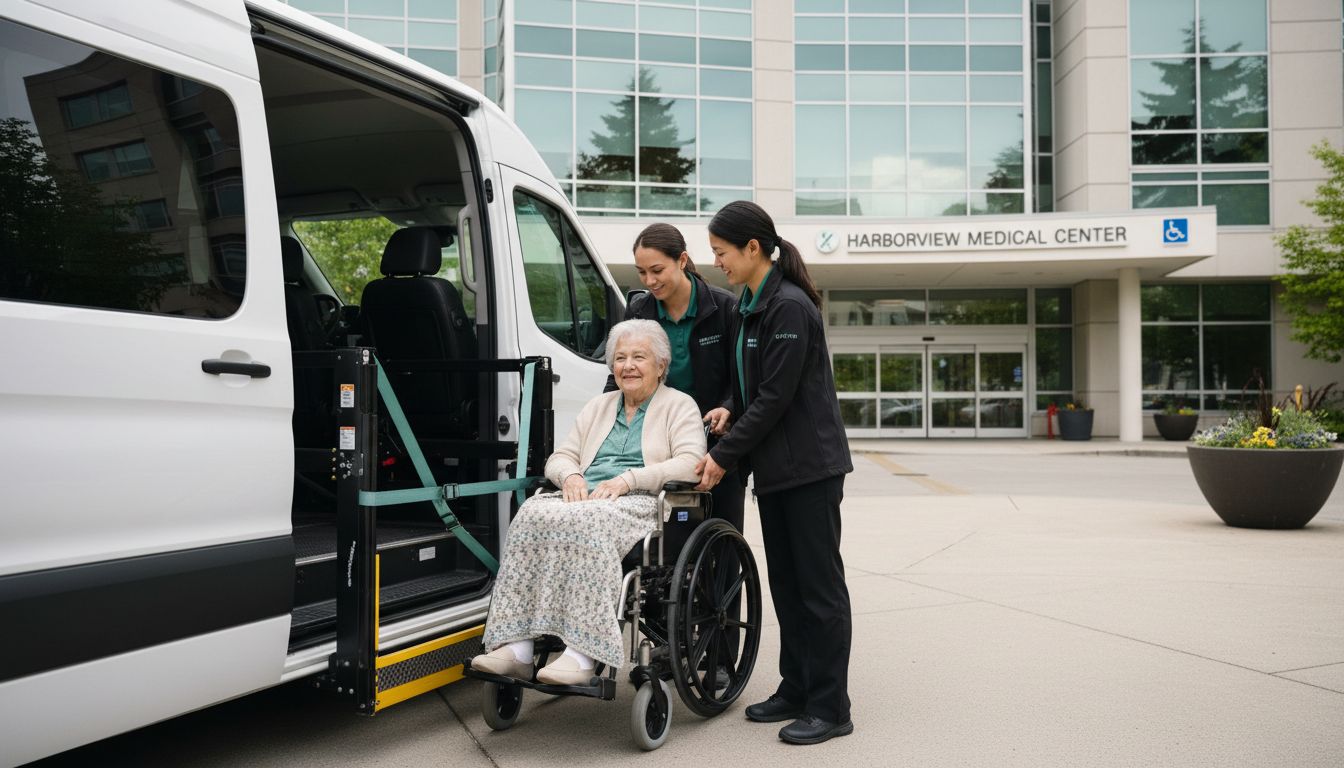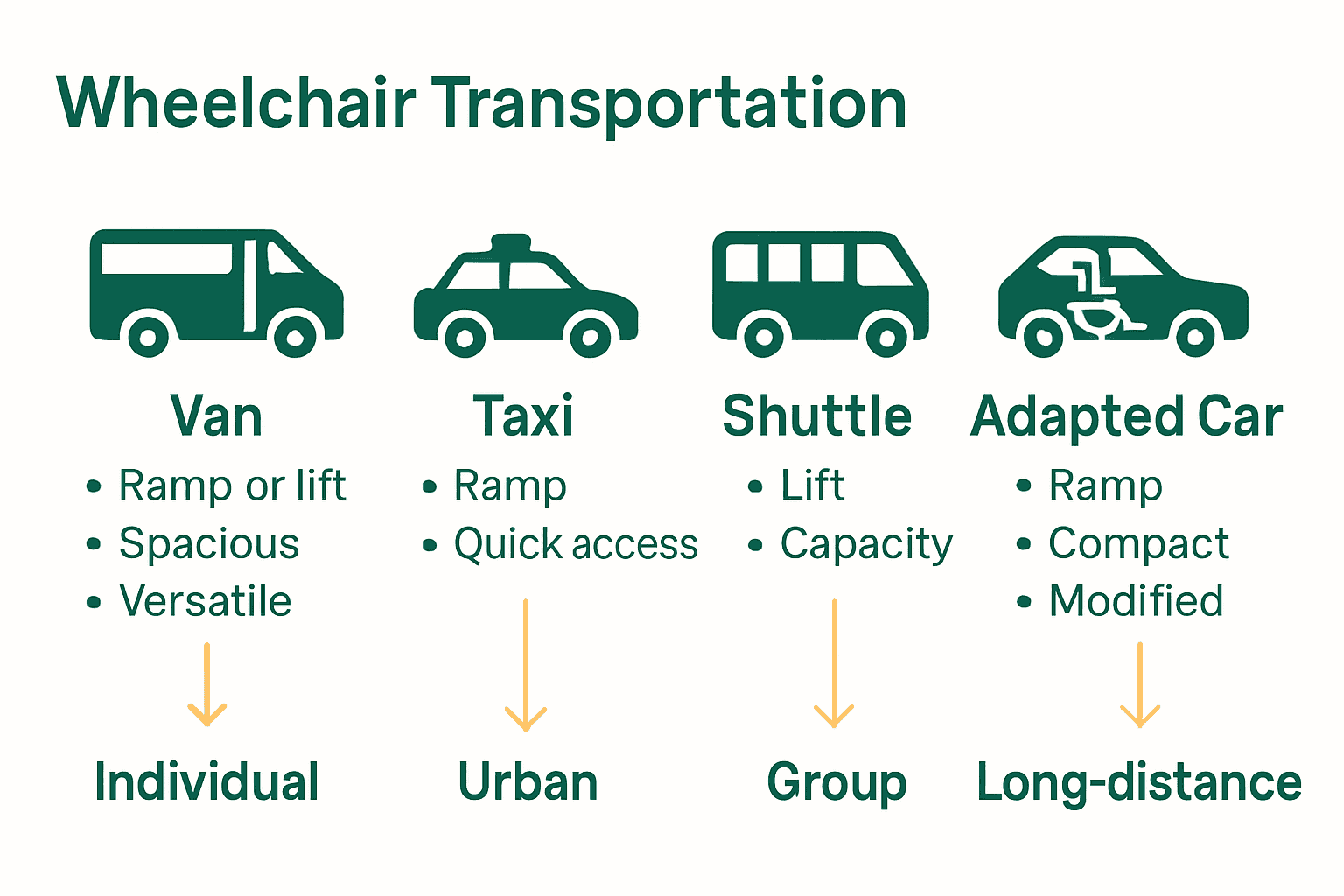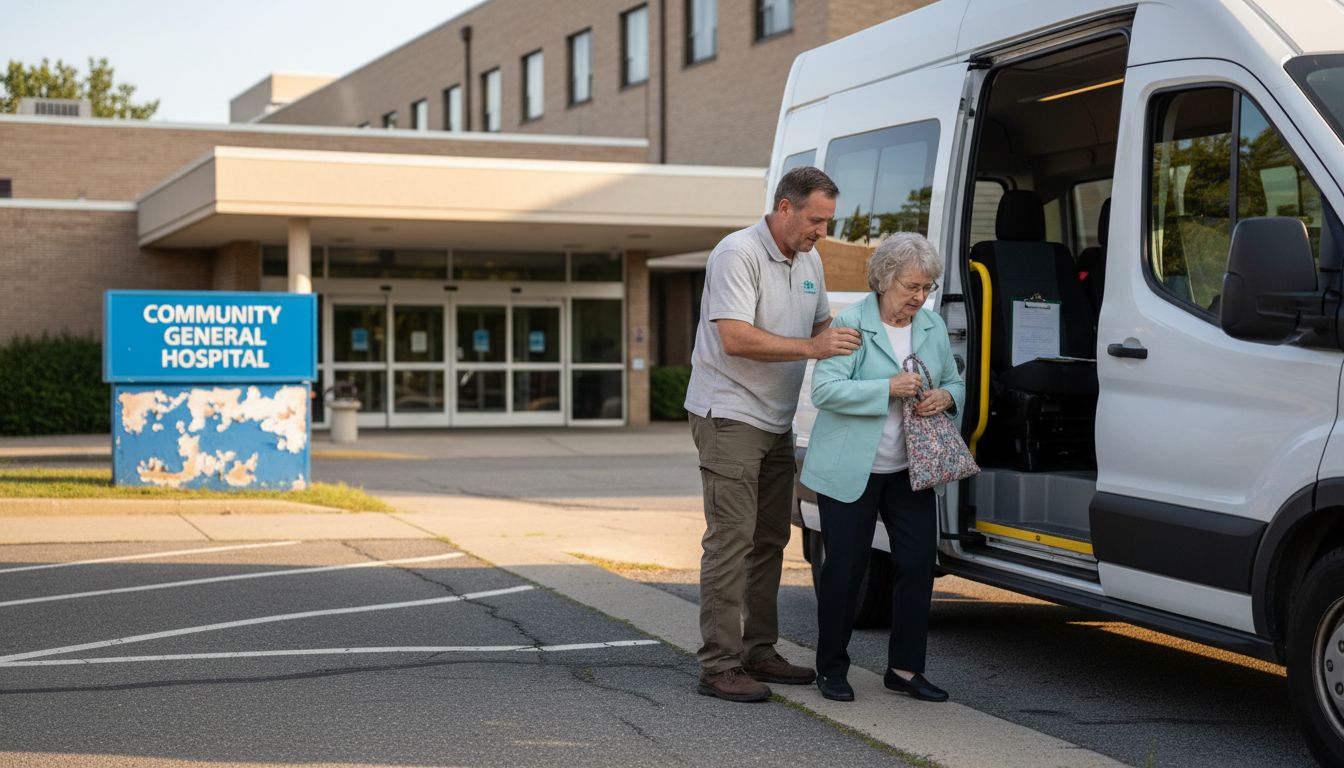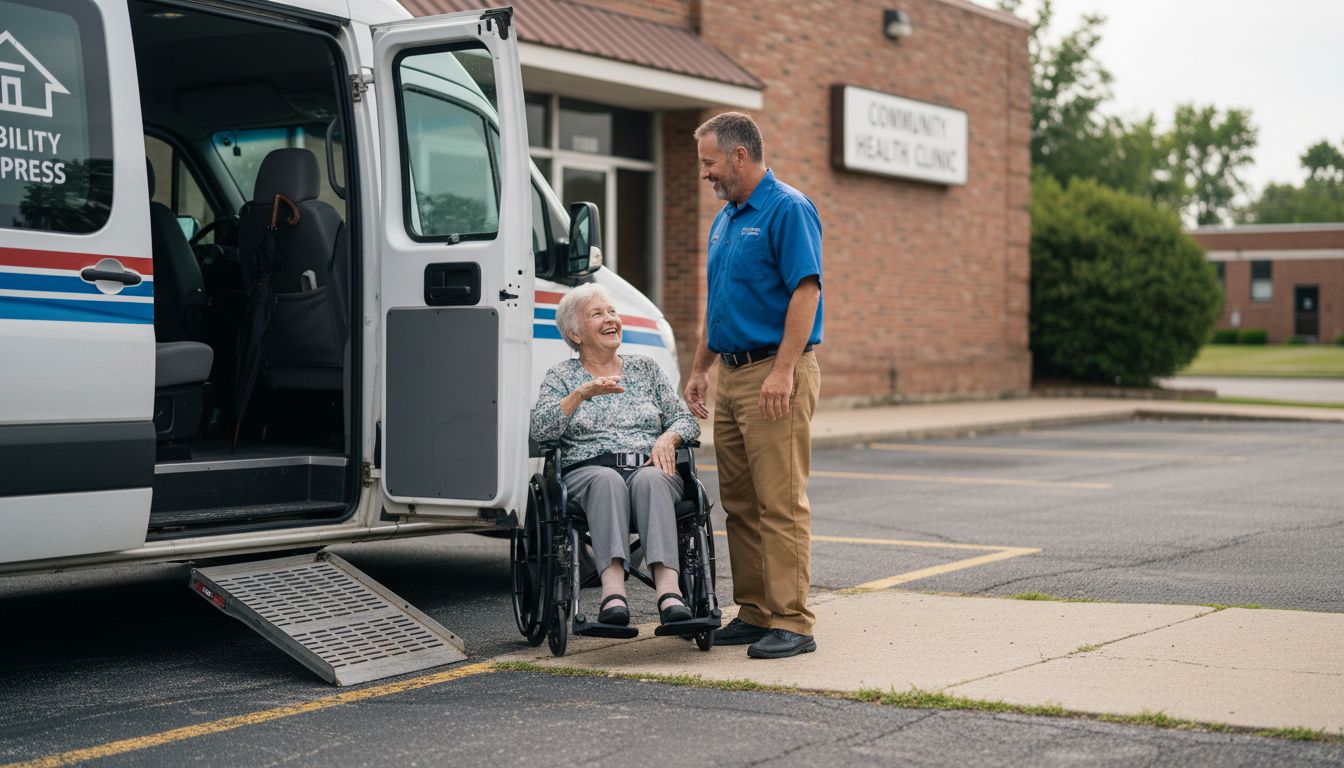Non Emergency Wheelchair Transportation Guide

Nearly 6.8 million Americans use assistive devices for mobility, making safe and reliable transportation a critical concern. Missing a single medical appointment can have serious health consequences, especially for those who rely on wheelchairs. Choosing the right non emergency wheelchair transportation helps ensure people with mobility challenges receive proper care, comfort, and dignity every step of the way.
Table of Contents
- Defining Non Emergency Wheelchair Transportation
- Types of Services and Vehicle Options
- Booking Procedures and Eligibility Requirements
- Compliance, Safety, and Regulatory Standards
- Cost Factors, Coverage, and Billing Insights
Key Takeaways
| Point | Details |
|---|---|
| Specialized Transportation | Non-emergency wheelchair transportation is essential for individuals with mobility challenges, ensuring access to medical care with various vehicle options. |
| Eligibility Criteria | Booking requires documented medical necessity, lack of alternatives, and confirmation of medical appointments, often necessitating 24-48 hours advance scheduling. |
| Safety Standards | Providers must adhere to strict safety and regulatory standards, including driver training, vehicle inspections, and specialized securement systems for passenger protection. |
| Cost Considerations | Medicaid typically covers these services, but costs can vary based on vehicle type and travel distance, with potential copayments or income-based fees applying. |
Defining Non Emergency Wheelchair Transportation
Non-emergency wheelchair transportation represents a specialized medical transport service designed to help individuals with mobility challenges reach medical appointments, rehabilitation centers, and other essential healthcare destinations. According to Macpac, this critical service provides transportation for individuals who lack alternative means of travel, ensuring they can access necessary medical care.
At its core, non-emergency wheelchair transportation involves moving patients who require assistive mobility devices between healthcare facilities or from their residence to medical appointments. CMS highlights that these transportation services encompass multiple vehicle types, including:
- Specialized wheelchair-accessible vans
- Modified taxis
- Adapted shuttle buses
- Personal medical transport vehicles
The primary goal of non-emergency wheelchair transportation is to provide safe, comfortable, and dignified transit for patients with physical limitations. These services are particularly crucial for individuals who:
- Use wheelchairs as their primary mobility device
- Cannot safely transfer into standard vehicle seats
- Require professional assistance during transportation
- Need specialized equipment or medical support while traveling
Understanding these nuanced transportation needs helps healthcare providers and medical transport services design more inclusive and patient-centered mobility solutions.
Types of Services and Vehicle Options
Non-emergency wheelchair transportation encompasses a diverse range of vehicle options and service types designed to meet the unique mobility needs of patients. CMS highlights that transportation services must be carefully tailored to accommodate individual medical conditions and mobility requirements.
The primary vehicle categories for non-emergency wheelchair transportation include:
- Wheelchair-Accessible Vans: Fully modified vehicles with hydraulic lifts, secure wheelchair restraints, and specialized safety equipment
- Modified Taxis: Compact vehicles adapted with wheelchair ramps and removable passenger seating
- Medical Transport Shuttles: Larger vehicles designed for multiple wheelchair passengers with professional medical staff
- Personal Adapted Vehicles: Private cars or SUVs modified with wheelchair loading mechanisms
Macpac emphasizes that the selection of transportation mode depends on several critical factors:
- Patient’s specific medical needs
- Distance of medical travel
- Required level of medical supervision
- Patient’s mobility equipment specifications
- Geographic terrain and transportation infrastructure
Beyond vehicle selection, these services often provide additional support such as door-to-door assistance, professional medical attendants, and specialized equipment handling. This comprehensive approach ensures patients receive safe, comfortable, and dignified transportation to their medical appointments.

Here’s a comparison of non-emergency wheelchair transportation vehicle options:

| Vehicle Type | Key Features | Best For |
|---|---|---|
| Wheelchair-Accessible Vans | Hydraulic lifts Secure restraints Safety gear |
Most wheelchair users Standard trips |
| Modified Taxis | Ramps Flexible seating arrangements |
Urban areas Short-distance travel |
| Medical Transport Shuttles | Multiple wheelchair spots Medical staff onboard |
Group trips Patients needing supervision |
| Personal Adapted Vehicles | Private use Custom loading mechanisms |
Individualized needs Long-distance trips |
Booking Procedures and Eligibility Requirements
Non-emergency wheelchair transportation requires a structured approach to booking and specific eligibility criteria to ensure patients receive appropriate medical transport services. CMS outlines that beneficiaries must typically contact their state’s Medicaid agency or designated transportation broker to initiate the booking process.
Key eligibility requirements for non-emergency wheelchair transportation generally include:
- Documented medical necessity for specialized transportation
- Lack of alternative transportation options
- Confirmed medical appointment or treatment
- Physician verification of mobility limitations
- Active Medicaid or approved insurance coverage
Macpac emphasizes that the booking procedure involves several critical steps:
- Medical Documentation Submission
- Transportation Need Assessment
- Vehicle Type Determination
- Scheduling Confirmation
- Pre-Transportation Verification
Patients or their healthcare providers must typically provide comprehensive medical documentation demonstrating the specific transportation requirements. This includes detailed information about mobility restrictions, required medical equipment, and the nature of the medical appointment. Advanced scheduling is recommended, with most services requiring at least 24-48 hours notice to ensure appropriate vehicle and staff allocation.
Compliance, Safety, and Regulatory Standards
Non-emergency wheelchair transportation demands rigorous adherence to comprehensive safety and regulatory standards to protect passengers with mobility challenges. CMS emphasizes that providers must strictly comply with federal and state regulations to ensure secure and reliable transportation services.
Critical safety requirements for wheelchair transportation include:
- Mandatory driver training in disability assistance
- Crash-tested wheelchair securement systems
- Regular vehicle safety inspections
- Proper occupant restraint mechanisms
- Accessibility equipment maintenance protocols
Wheelchair Transportation Safety Research highlights that passenger protection goes beyond basic transportation, requiring specialized understanding of regulatory compliance in healthcare. This involves comprehensive safety protocols that address:
- Vehicle modification standards
- Emergency response preparedness
- Medical equipment transportation guidelines
- Passenger screening procedures
- Continuous staff training requirements
Providers must implement multilayered safety strategies that protect passengers’ physical well-being while maintaining dignity and independence. This holistic approach ensures that non-emergency wheelchair transportation meets the highest standards of medical transport safety and regulatory compliance.
Cost Factors, Coverage, and Billing Insights
Non-emergency wheelchair transportation involves a complex financial landscape with multiple coverage and billing considerations. CMS explains that Medicaid typically covers these services for eligible beneficiaries, with costs varying significantly based on transportation mode and travel distance.
Key cost factors influencing wheelchair transportation include:
- Vehicle type and modification complexity
- Distance of medical transport
- Level of medical assistance required
- Geographic region and local transportation infrastructure
- Patient’s specific mobility needs
Macpac highlights that while Medicaid generally provides coverage, states may implement different approaches to healthcare cost containment strategies. Beneficiaries might encounter:
- Nominal copayment requirements
- Sliding scale fee structures
- Income-based cost-sharing mechanisms
- Prior authorization processes
- Specific documentation requirements
Understanding these financial nuances is crucial for patients, healthcare providers, and transportation services to navigate the complex reimbursement landscape effectively. Proactive communication and thorough documentation remain essential in managing the financial aspects of non-emergency wheelchair transportation.
Simplify Non-Emergency Wheelchair Transportation with VectorCare
Non-emergency wheelchair transportation involves many complex factors like specialized vehicle coordination, patient eligibility verification, and strict safety compliance. For healthcare providers and agencies, managing these elements efficiently can feel overwhelming and crucial for patient dignity and care. VectorCare’s digital platform is designed precisely to meet these challenges by automating scheduling, optimizing dispatch, and providing real-time updates that help reduce delays and improve patient outcomes.

Take control of your patient transportation logistics today by leveraging VectorCare’s integrated tools. Whether you are coordinating wheelchair-accessible vans, managing medical transport shuttles, or arranging essential door-to-door assistance, VectorCare streamlines every step. Visit VectorCare now to discover how our platform supports compliance, enhances communication, and drives cost savings for your organization. Start transforming your non-emergency wheelchair transportation services for reliable, dignified care that patients deserve.
Frequently Asked Questions
What is non-emergency wheelchair transportation?
Non-emergency wheelchair transportation is a specialized service designed to transport individuals with mobility challenges to medical appointments, rehabilitation centers, and other healthcare destinations. This service uses vehicles modified for wheelchair access, ensuring safe and comfortable transit.
What types of vehicles are used for non-emergency wheelchair transportation?
The vehicles used typically include wheelchair-accessible vans, modified taxis, medical transport shuttles, and personal adapted vehicles. Each type is tailored to meet specific mobility needs and to provide the required level of assistance.
What are the eligibility requirements for using non-emergency wheelchair transportation?
Eligibility generally includes documented medical necessity for transportation, lack of alternative travel options, confirmed medical appointments, physician verification of mobility limitations, and active Medicaid or approved insurance coverage.
What factors influence the cost of non-emergency wheelchair transportation?
Cost factors include the type and complexity of the vehicle required, the distance of the transport, the level of medical assistance needed, local transportation infrastructure, and the specific mobility needs of the patient.



